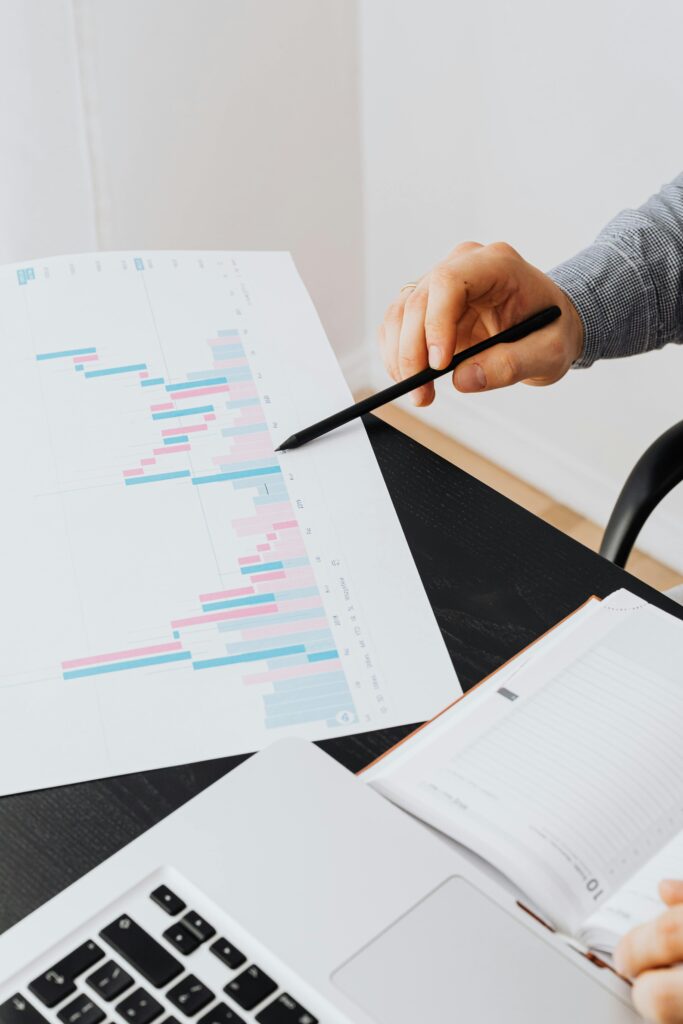In the complex world of business, understanding economic indicators is crucial for making informed decisions. One of the most significant among these is the Purchasing Managers’ Index (PMI). The PMI economic indicator serves as a vital tool for business leaders, offering insights into the economic health of various sectors. It is derived from a monthly survey of purchasing managers, reflecting their perceptions of business conditions, including new orders, production, employment, and supplier deliveries.
As a leading economic indicator, PMI provides valuable foresight into future economic activity. A PMI reading above 50 typically signals expansion, while a reading below 50 indicates contraction. This makes it an essential barometer for business leaders aiming to navigate the uncertainties of economic fluctuations. Understanding how PMI correlates with broader economic trends, such as GDP growth, can empower leaders to make strategic decisions that enhance operational efficiency and competitive advantage.
The purpose of this article is to explore the role of the PMI economic indicator as a leading indicator for forecasting economic trends. By delving into its components, analyzing historical data, and discussing practical applications, we aim to equip business leaders with the knowledge necessary to leverage PMI for strategic planning and informed decision-making.
Understanding the PMI
Components of the PMI
The Purchasing Managers’ Index (PMI) is a composite index derived from five key components, each reflecting different aspects of economic activity within the manufacturing and services sectors. These components are:
- New Orders: A measure of new purchase orders placed with suppliers. An increase in new orders indicates rising demand, which is often a precursor to higher production levels.
- Production Levels: This component assesses the current production output of businesses. Higher production levels suggest economic expansion and increased business activity.
- Employment: This reflects changes in employment levels within the sector. An increase in employment typically correlates with business growth and rising demand for goods and services.
- Supplier Deliveries: This measures the speed at which suppliers deliver materials. Slower delivery times can indicate higher demand for goods, suggesting a growing economy.
- Inventory Levels: This component evaluates the inventory held by businesses. Changes in inventory levels can indicate whether firms are anticipating higher demand or preparing for potential downturns.
How PMI is Calculated
The PMI is calculated through a survey conducted among purchasing managers across various industries. Each component is assigned a weight, and the responses are transformed into a single index value. The formula typically involves the following steps:
- Survey respondents indicate whether business conditions are improving, unchanged, or declining.
- Each response is assigned a numerical value: 1 for “decreasing,” 2 for “unchanged,” and 3 for “increasing.”
- The results are averaged and adjusted to create a final index score, which ranges from 0 to 100.
A score above 50 indicates expansion, while a score below 50 signals contraction. This simplicity in calculation allows business leaders to quickly assess economic conditions.
Example: Suppose we have the following survey results:
| Category | % Reporting Improvement | % Reporting Deterioration |
| New Orders | 25% | 10% |
| Production | 20% | 15% |
| Employment | 15% | 5% |
| Supplier Deliveries | 10% | 20% |
| Inventories | 5% | 10% |
Calculate Indices:
- New Orders Index = [25 – 10] + 50 = 65
- Production Index = [20 – 15] + 50 = 55
- Employment Index = [15 – 5] + 50 = 60
- Supplier Deliveries Index = [10 – 20] + 50 = 40
- Inventories Index = [5 – 10] + 50 = 45
Calculate PMI:
PMI = (1/5) × [ (65 × 0.3) + (55 × 0.25) + (60 × 0.2) + (40 × 0.15) + (45 × 0.1) ]
PMI = (1/5) × [19.5 + 13.75 + 12 + 6 + 4.5]
PMI = (1/5) × 55.75
PMI = 55.75
Interpretation:
Since the PMI is 55.75, which is above 50, it indicates expansion/growth in the manufacturing sector.
Note:
- Actual survey results may vary.
- Weights may differ depending on the organization conducting the survey (e.g., Markit, ISM).
- This example is simplified for illustration purposes.
Different Types of PMI
There are two primary types of PMI: Manufacturing PMI and Services PMI.
- Manufacturing PMI focuses on the manufacturing sector, providing insights into production, employment, and new orders. It is particularly relevant for businesses involved in manufacturing, as it can indicate supply chain trends and raw material costs.
- Services PMI covers the services sector, which constitutes a significant portion of most economies. This index provides insights into the health of services such as finance, healthcare, and retail, making it essential for service-oriented businesses.
For further reading on the significance of PMI in economic forecasting, you can explore resources like the Institute for Supply Management and Markit Economics.
PMI as a Leading Economic Indicator
Definition of Leading Indicators
Leading indicators are economic factors that change before the economy starts to follow a particular trend. They provide foresight into future economic activity, making them invaluable for business leaders. Unlike lagging indicators, which reflect past performance, leading indicators can help predict future movements in the economy. The PMI is a prominent example of a leading indicator, serving as an early signal of economic expansion or contraction.
Historical Context: PMI’s Role in Economic Forecasting
Historically, the PMI has proven to be a reliable predictor of economic trends. For instance, during periods of economic growth, PMI readings tend to rise, reflecting increased business activity and confidence. Conversely, falling PMI values often precede economic downturns, signaling potential challenges ahead.
Research has shown that changes in PMI often correlate with shifts in GDP growth. A study by the Federal Reserve found that the PMI can lead GDP changes by several months, making it an essential tool for forecasting economic conditions. For business leaders, understanding this relationship can enhance their strategic planning efforts.
Correlation Between PMI and GDP Growth
The correlation between PMI and GDP growth is significant. When PMI readings are consistently above 50, they indicate a robust expansion in economic activity, often aligning with rising GDP. Conversely, PMI readings below 50 suggest economic contraction, which can precede declines in GDP.
For example, during the recovery from the 2008 financial crisis, PMI readings began to rise before GDP growth became apparent, allowing businesses to prepare for an upswing. This predictive nature of the PMI enables leaders to make proactive decisions regarding investments, hiring, and resource allocation.
You can also Read: What is a Chartered Financial Analyst

Analyzing PMI Trends
Interpreting PMI Readings
Interpreting PMI readings is essential for understanding the current economic landscape. The index is designed to provide a clear indication of business conditions:
- Above 50: A reading above 50 suggests that the manufacturing or services sector is expanding. This indicates increased production, higher orders, and potential job growth. Business leaders can use this information to plan for scaling operations, increasing workforce, and investing in new projects.
- Exactly 50: A reading at 50 signifies no change in economic activity. This neutral scenario suggests stability but may also indicate that businesses should remain cautious and prepared for potential shifts in demand.
- Below 50: A reading below 50 indicates contraction. This suggests declining orders, reduced production, and potential layoffs. Business leaders should consider this a warning sign to reassess their strategies, cut costs, or adjust inventory levels.
Case Studies: Historical PMI Trends and Their Economic Impacts
Examining historical PMI trends can provide valuable insights into economic cycles. For instance, during the onset of the COVID-19 pandemic in early 2020, PMI readings plummeted to historic lows. This decline foreshadowed widespread economic disruptions, allowing businesses to implement contingency plans.
Another notable case is the period leading up to the 2008 financial crisis. PMI readings began to decline months before the crisis hit, giving forward-looking companies an opportunity to adjust their strategies. By analyzing these trends, business leaders can better anticipate downturns and prepare their organizations accordingly.
Sector-Specific Insights: How Different Industries React to PMI Changes
Different industries react uniquely to changes in PMI readings. For instance:
Manufacturing Sector: This sector is highly sensitive to PMI fluctuations. A rise in the Manufacturing PMI can lead to increased production schedules and hiring, as companies anticipate greater demand for their products.
Services Sector: While less volatile than manufacturing, the Services PMI can signal shifts in consumer spending and business investment. An improving Services PMI often correlates with higher consumer confidence, prompting businesses to expand their offerings or enhance service quality.
Understanding these sector-specific dynamics allows business leaders to tailor their strategies based on the PMI’s implications for their industry.
Practical Applications for Business Leaders
Strategic Planning and Decision-Making
Understanding PMI data can significantly enhance strategic planning and decision-making processes for business leaders. By integrating PMI insights, leaders can better anticipate market conditions and align their operational strategies accordingly. For example:
Resource Allocation: When PMI readings indicate expansion, businesses can justify increasing inventory levels and investing in production capabilities. Conversely, if the PMI signals contraction, leaders might prioritize cost-cutting measures or defer new investments.
Budgeting and Forecasting: PMI data can inform financial forecasts, helping leaders establish realistic budgets. By anticipating changes in economic activity, businesses can prepare for fluctuations in revenue and adjust their spending plans accordingly.
Identifying Growth Opportunities
PMI readings provide valuable insights into potential growth opportunities. When the index shows consistent expansion, business leaders can explore new markets or product lines. Specific applications include:
- Market Expansion: A rising PMI may suggest a growing economy and increased consumer spending. Leaders can leverage this information to enter new geographic markets or expand their customer base.
- New Product Development: Positive PMI trends can signal consumer demand for innovative products. Businesses can invest in research and development to create offerings that meet emerging market needs.
Risk Management
PMI serves as an essential tool for risk management, enabling leaders to identify and mitigate potential economic risks. By monitoring PMI trends, businesses can:
Prepare for Economic Downturns: A declining PMI can be an early warning sign of economic challenges. Business leaders can use this information to adjust their strategies proactively, such as reducing workforce size or managing inventory levels to avoid overstocking.
Adjusting Operational Strategies: Understanding the economic environment allows businesses to remain agile. If PMI indicates a slowdown, leaders can shift focus to cost efficiency, optimizing operations to preserve cash flow and maintain profitability.
Also Read: The Impact of Political Risk on Investment in Emerging Markets

Limitations of the PMI
While the Purchasing Managers’ Index (PMI) is a valuable tool for economic forecasting, it is essential for business leaders to recognize its limitations. Understanding these constraints can help organizations make more informed decisions and avoid overreliance on a single indicator.
Potential Inaccuracies and Biases
The PMI is derived from surveys of purchasing managers, which means that it can be influenced by subjective perceptions and biases. Some limitations include:
- Respondent Bias: Purchasing managers may have optimistic or pessimistic views based on their own experiences, leading to skewed results. For example, if a manager has recently experienced supply chain disruptions, they may predict a downturn even if broader economic conditions are stable.
- Sampling Issues: The PMI relies on responses from a sample of purchasing managers. If the sample is not representative of the broader economy or specific industries, the results may not accurately reflect economic conditions.
External Factors Influencing PMI Readings
Various external factors can impact PMI readings, making it necessary for business leaders to consider these influences when interpreting the index:
- Seasonality: Certain industries experience seasonal fluctuations that can distort PMI readings. For instance, retail may see a spike in activity during holiday seasons, which could inflate PMI numbers temporarily.
- Geopolitical Events: Global events, such as trade disputes or natural disasters, can significantly affect supply chains and production levels, leading to abrupt changes in PMI readings that may not reflect underlying economic trends.
- Economic Policy Changes: Shifts in government policies, such as changes in interest rates or tax legislation, can influence business sentiment and operations, impacting PMI readings in ways that may not align with actual market conditions.
Further Read: The Role of Currency Exchange Rates in Economic Forecasting

Importance of Using PMI Alongside Other Economic Indicators
To mitigate the limitations of the PMI, it is crucial for business leaders to use it in conjunction with other economic indicators. Some complementary indicators include:
Gross Domestic Product (GDP): While PMI provides timely data, GDP offers a broader view of economic health and performance over a longer period.
Consumer Confidence Index (CCI): This index measures consumer sentiment and spending behaviors, providing insights into future demand that can complement PMI data.
Unemployment Rate: Monitoring employment levels can help business leaders gauge overall economic stability and consumer spending power.
While the PMI economic indicator is a powerful tool for forecasting economic trends, it is not infallible. By understanding its limitations and using it in conjunction with other economic indicators, business leaders can make more informed decisions. This multi-faceted approach enables organizations to navigate economic uncertainties with greater confidence and agility.
Also Read: Why Retail Sales Figures Are a Leading Economic Indicator
Conclusion
In the dynamic landscape of modern business, staying informed about economic indicators is crucial for strategic decision-making. The Purchasing Managers’ Index (PMI) stands out as a leading economic indicator, providing valuable insights into future economic trends and the health of various sectors. This article has explored the components of the PMI, its historical significance, and its practical applications for business leaders.
As economic conditions continue to evolve, business leaders must leverage PMI data not just as a standalone metric but as part of a broader strategy that includes various economic indicators. By doing so, they can enhance their understanding of market dynamics and improve their agility in responding to changes.
Moreover, integrating PMI analysis into regular business practices can foster a proactive organizational culture. Leaders who prioritize data-driven decision-making are better positioned to identify growth opportunities, mitigate risks, and optimize resource allocation.






